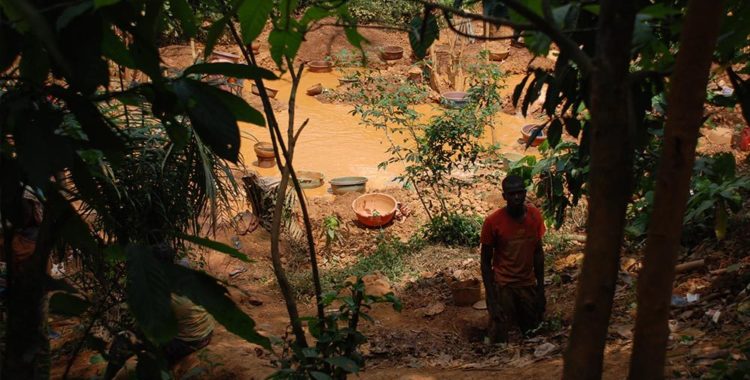Mitigating the environmental impacts of Large-scale Mining (LSM) has long been a priority on international conservation agendas. Risks to biodiversity posed by Artisanal and Small-scale Mining (ASM) receive comparably less attention, despite the severity of direct, indirect and cumulative impacts. Is ASM considered unmanageable and therefore slips down agendas? Could initiatives currently working on ASM join up their approaches to maximise positive impacts?
Environmentally and socially responsible mining, conducted with a developing awareness of best-practice approaches for avoiding and mitigating the environmental impacts of extraction, are becoming mainstreamed into how the LSM sector does business. Utilising the mitigation hierarchy approach to impact avoidance, minimising operational impacts, optimising rehabilitation success and biodiversity offsetting have become integrated into how many large-scale mining companies address their environmental impacts on biodiversity and enhance their license to operate.
Since the concepts of No Net Loss and Net Positive Impact were introduced to the mining sector in the early 2000s, organisations such as the International Council on Mining and Metals (ICMM) and initiatives like the Business and Biodiversity Offsets Programme (BBOP) have facilitated the development of guidelines and tools to assist mining companies in reducing their environmental footprints, from exploration through to mine closure. Many of the world’s leading mining companies are now implementing these disciplines, in many cases supported and supplemented by environmental and social performance standards required through financial institutions such as the International Finance Corporation (IFC) and European Bank for Reconstruction and Development (EBRD). Such performance standards (PS) for the Environment (PS6, ‘Biodiversity Conservation and Sustainable Management of Living Natural Resources’, in particular) are now widely implemented, ensuring that biodiversity is factored into new mining projects, including through the Equator Banks. We are now seeing a much higher standard of biodiversity planning, implementation and management across the LSM sector, with such global standards now encouraging more junior members of the sector to improve their biodiversity performance.
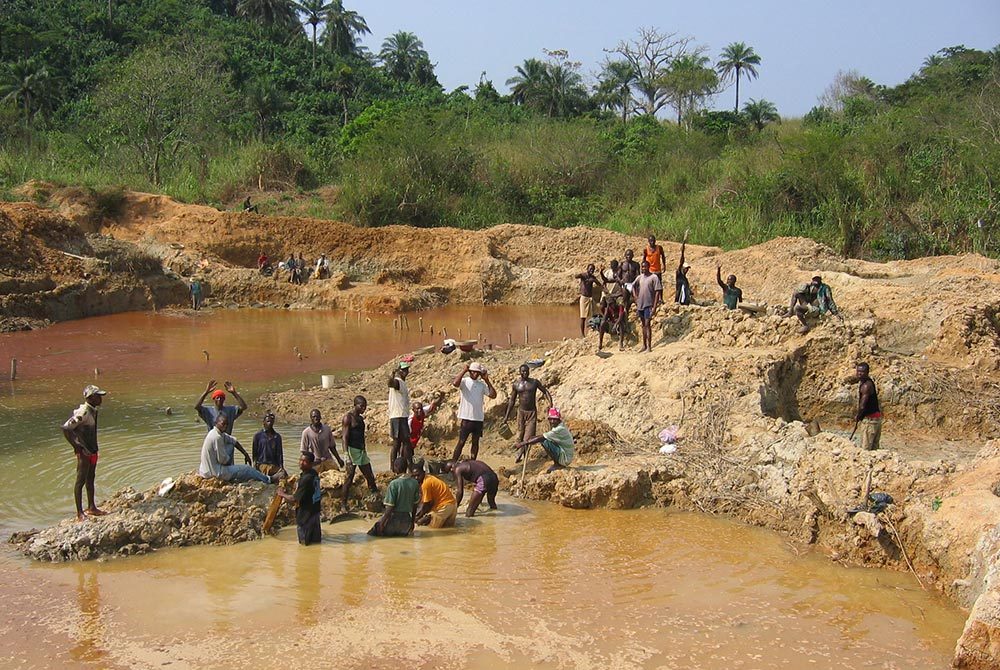
However, at the far end of the mining spectrum, ASM is a significant and growing sub-sector that is generally poverty-driven in the countries where it occurs. ASM sustains the livelihoods of an estimated 150 million people worldwide – that’s more people than there are living in Russia in 2018. It is a significant source of many commodities and products that are in high demand globally: 20% of gold production, 20% of diamonds, 80% of coloured gemstones, 26% of global tantalum production and 25% of global tin production (essential for batteries and green technologies). Given that much of the sub-sector is informal, ASM is often thought of as unknowable and unmanageable, and therefore its impacts and stakeholders are often overlooked and not considered a priority on national and international environmental protection agendas
The environmental impacts of the sector are, however, important to identify and address. Many of the same impacts associated with poorly managed LSM are prevalent throughout the ASM sub-sector, including:
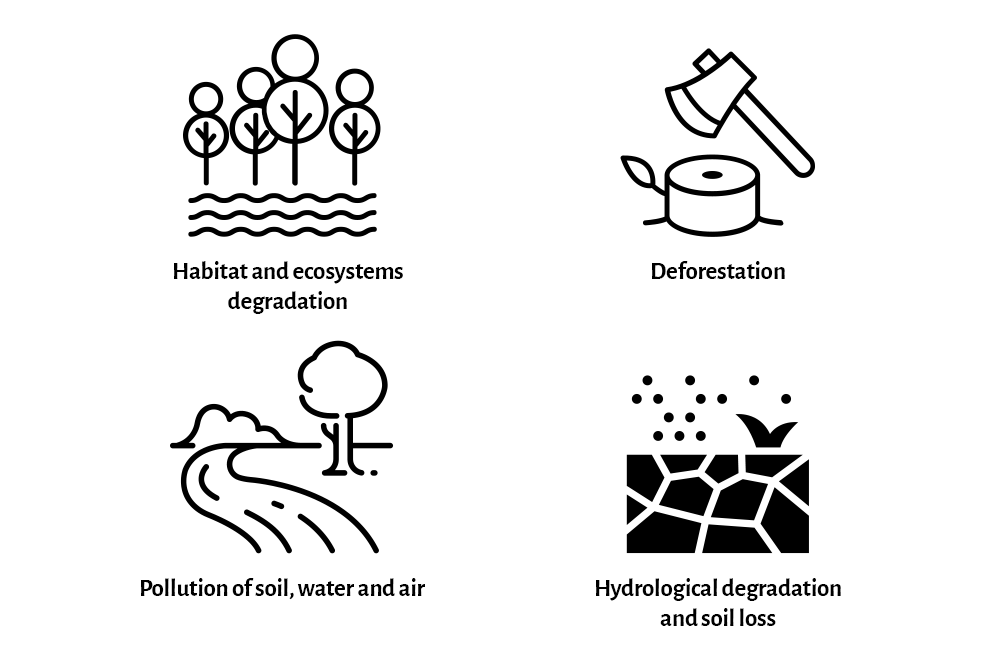
The scale of these issues is not fully appreciated and the direct, indirect and cumulative impacts of unregulated ASM activities can be severe. Alongside the impacts shared across sectors, ASM presents unique risks, including:
- The ability of ASM actors to rapidly establish a presence in remote areas
- Lack of formal access to land often drives miners into protected areas, catchments and transboundary areas - many of which are designated as protected
- Actions and policies concerning ASM are often reactive, fragmented, isolated and ineffective
- Lack of regulation means environmental impacts are poorly documented and therefore the scale is difficult to fully appreciate and respond to appropriately
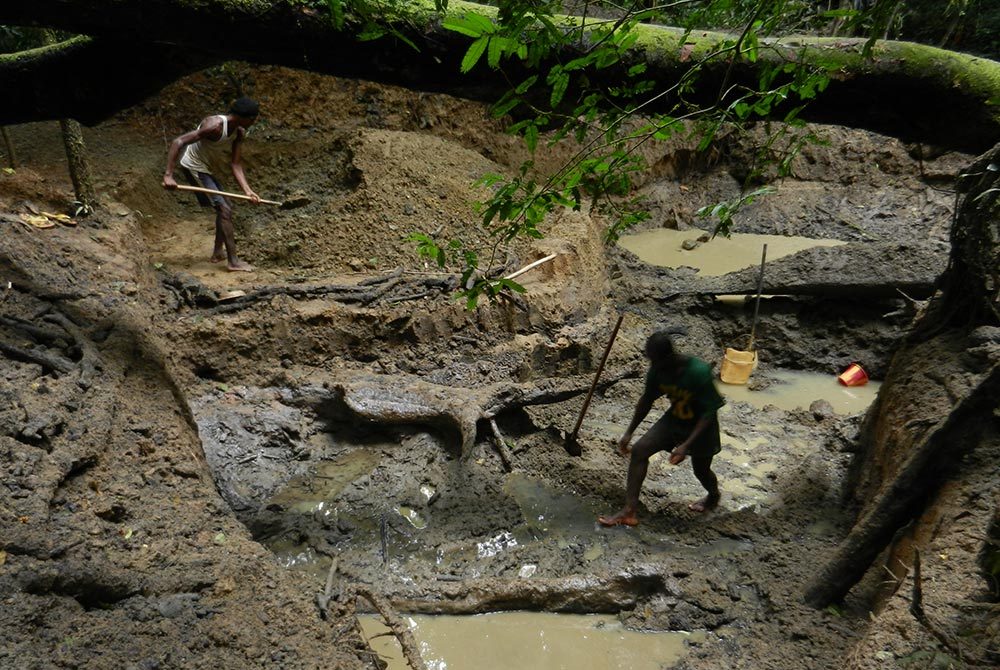
To date, there are no internationally agreed best practices to address the negative environmental impacts ASM has on biodiversity and ecosystem services. Despite there being several initiatives working in parallel on different issues and geographies, it is in a largely disaggregated manner that would benefit from harmonisation to be a true catalyst for an integrated and more effective response. The LSM sector has access to a range of best practices and initiatives that address social and environmental issues, developed through a membership-based forum and facility. The ICMM brings together 27 mining and metals companies and over 30 national, regional and commodity-specific associations to address and strengthen social and environmental performance. Through its membership, ICMM has developed and disseminated environmental best practices, appropriate solutions and mitigation strategies that are accessible to governments, civil society and other stakeholders. In contrast, without such a global representative body, there is, at present, no equivalent organisation or resource for the ASM sub-sector.
The formal harmonisation of the activities of stakeholders and initiatives presents an opportunity to catalyse a pressing need to focus on the environmental impacts of ASM. The World Bank and OECD are exploring options and opportunities for the development of a World Centre of Excellence focusing on ASM. The initiative is, at the time of writing, in formative stages, and has goals to develop a donor-supported ASM Support Hub to provide solutions and knowledge/data centres for the benefit of host country governments, donors, global mining companies and the ASM community. Once developed, this knowledge centre will form an important source to gather local initiatives, identify global trends and establish international best practices for ASM.
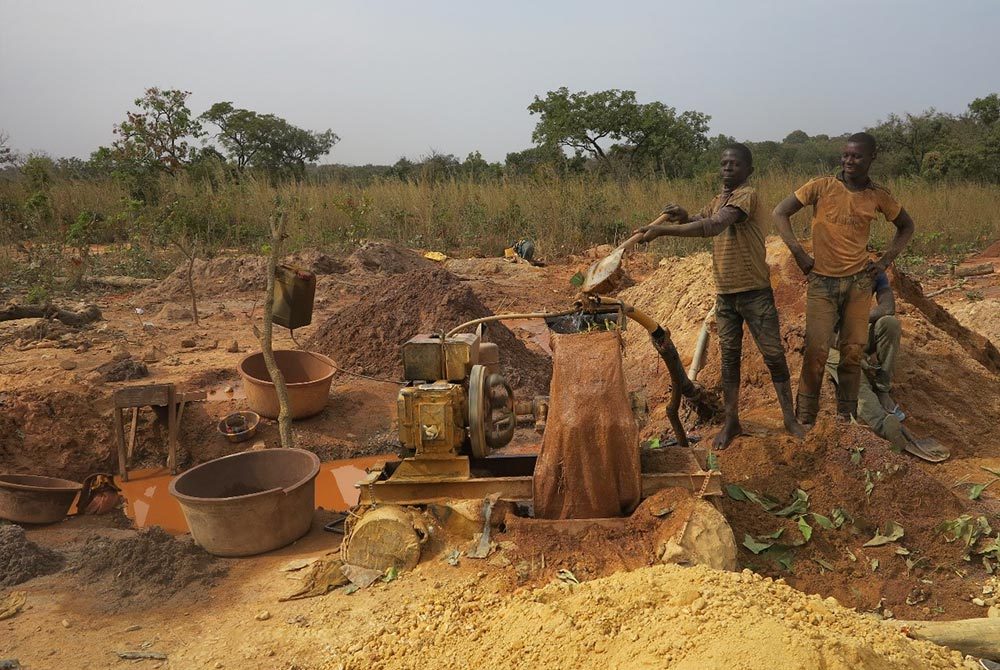
The current disaggregated nature of existing initiatives reflects the disparate nature and understanding of the management, impacts and geographies of ASM activities. Initiatives exploring how to mitigate such ASM impacts as deforestation, mercury contamination, and the promotion of community-based governance and mine-site rehabilitation are generating data and influencing policies in specific areas. Recognising this diversity, identifying trends and seeking strategically adaptive entry points in a holistic, integrated and coordinated approach is a key step towards achieving greater recognition of the sector’s contributions to addressing its negative environmental impacts both locally and globally. Profiling the need to scale up and replicate such capacities through funding for mitigation and remediation strategies though partnership-based initiatives between governments, the private sector and development agencies should be a priority objective to be realised urgently. This issue and the opportunities it presents was profiled earlier this month by Levin Sources at a session on Mainstreaming Biodiversity in the Mining Sector at the Business and Biodiversity Forum recently held in association with the UN Biodiversity Conference (CoP14) in Sharm El Sheikh, Egypt.
The scale of the threat to biodiversity and ecosystems posed by poorly managed ASM operations is not fully appreciated and its social and economic challenges are complex. Environmentally responsible, formalised ASM can be promoted and can contribute positively to local and national economies. There are practical and affordable solutions, but these issues and potential solutions need to be highlighted and priorities by governments, industry and market policy-makers, and downstream private sector organisations.
The number of ASM miners has, over the last 25 years, grown by almost 600 percent and, as the rate of population growth continues to increase, this upwards curve will only continue. The social realities of those practicing ASM as part of their livelihood strategies means it is a sector that must be prioritised – not marginalised – if biodiversity is to be truly mainstreamed across mining.
A small section of initiatives focused on environmental management in ASM:
The Code of Risk-mitigation for artisanal and small-scale mining engaging in Formal Trade (CRAFT Code) is a tool developed by the Alliance for Responsible Mining (ARM) that makes it easier for buyers to apply due diligence in the sector, with a focus on a continuous development and improvement. It is a gateway into the formal market for artisanal and small-scale miners, focused on the mitigation of the main ASM risks.
Minamata Convention on Mercury
A treaty established to reduce the human-caused emissions and releases of mercury into the environment. The Convention states which ASM gold mining practices should be forbidden and recommends practices that should be put in place to reduce usage. As of November 2018, the Convention has 128 signatories.
Global Environmental Facility (GEF)’s GOLD: Addressing Mercury Pollution from Artisanal Gold Mining
The GEF GOLD program will accelerate the development of the Artisanal and Small-scale Gold mining (ASGM) sector into a professional segment of the gold industry as part of the effort needed to reduce its mercury use and other deleterious environmental and social impacts. As one of its main goals, GOLD will develop and connect responsible ASGM producers to international markets through transparent supply chains.
The Mosi-oa-Tunya Declaration on ASM, Quarrying and Development was adopted by the delegates at the historic ASM18 conference in Zambia, 2018. The declaration includes a section on environmental protection, urging miners and governments to do all possible to avoid and minimise environmental harm and ensure effective oversight for environmental protection.
PROFOR Forest-Smart Mining: Identifying Good and Bad Practices of ASM in Forest Landscapes
PROFOR is a World Bank-managed multi-donor partnership that provides knowledge, tools and in-depth analysis to facilitate forests contribution to poverty reduction, sustainable economic development and the protection of global and local environmental services. A global study identifying good and bad practices of ASM in forest landscapes was undertaken in 2017-18 to assess what constitutes international best practices for mining in forested ecosystems.
The Sustainable Artisanal Mining (SAM) Project
An initiative that aimed to achieve an economically sustainable, human-rights based and environmentally responsible ASM sector in Mongolia. The current (and closing) phase of this project seeks to establish an ASM Knowledge Hub for best practices in Mongolia.
Engaging Stakeholders in Environmental Conservation (ESEC) II Project
An initiative by the Asia Foundation (co-funded by the Swiss Agency for Development and Cooperation SDC) designed to enhance the contribution of Mongolia’s ASM sector to sustainable local development through the development and use of toolkits for environmental rehabilitation and community-based environmental governance.
Fairtrade Certified Gold is the world's first independent ethical certification system for gold. The Fairtrade Gold certification is an independently audited criteria by Fairtrade International to enable artisanal and small-scale miners to improve their livelihoods, giving assurances to retailers and consumers that the miners are getting a fair deal for their work.
Fairmined is an assurance label that certifies gold from empowered ASM organisations who meet standards for responsible practices. It focuses transforming mining into an active force for good, ensuring social development and environmental protection.
Frugal Rehabilitation Methodology (FRM)
The FRM is a model for economically affordable, socially acceptable and ecologically viable rehabilitation of mined-out lands. It has been piloted successfully at 17 ASM-degraded lands in Mongolia, allowing for transformation for alternative economic activities after a period of regeneration.
ASM in Protected Areas and Critical Ecosystems (ASM-PACE)
A programme for the exploration and addressing of the impacts of ASM taking place in protected areas and critical ecosystems. The programme sought to find workable and sustainable solutions that balanced environmental concerns, human rights, and economic development, highlighting the developmental potential of well-managed ASM.
Biodiversity and Ecosystem Services Transformative Artisanal and Small-scale Mining (BEST-ASM)
This is a model - developed by Levin Sources - that has integrated the above three initiatives and their tools (ESEC II, FRM and ASM-PACE) to be adapted and applied to developing and realising ASM environmental best practice internationally .
BEST-ASM is covered in detail in the recent CRC Press publication ‘Extracting Innovations: Mining, Energy, and Technological Change in the Digital Age’.
CIRDI Environmental Assessment and Management for ASM
A guidance document for building the capacity of governments and miners to assess and manage environmental impacts of ASM.
Solidaridad’s manual on technologies to rehabilitate environmentally degraded areas
A manual that highlights good practices for the remediation of areas impacted by non-polluted alluvial ASM.
This article was written by Jack Cooper, with contributions from Jonathan Stacey, Estelle Levin-Nally and Blanca Racionero Gómez.


